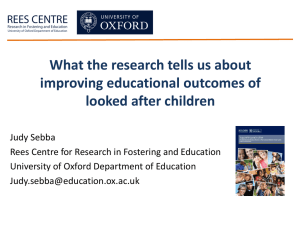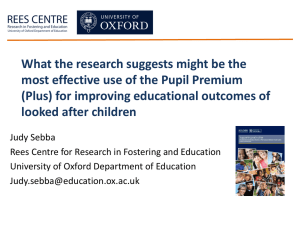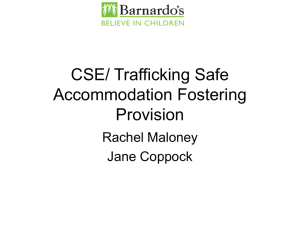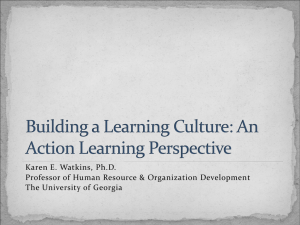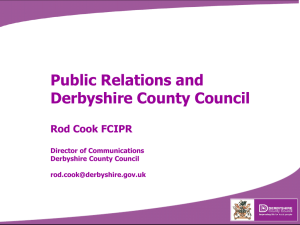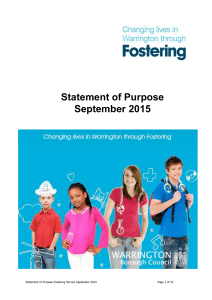Parent and child fostering - REES Centre
advertisement
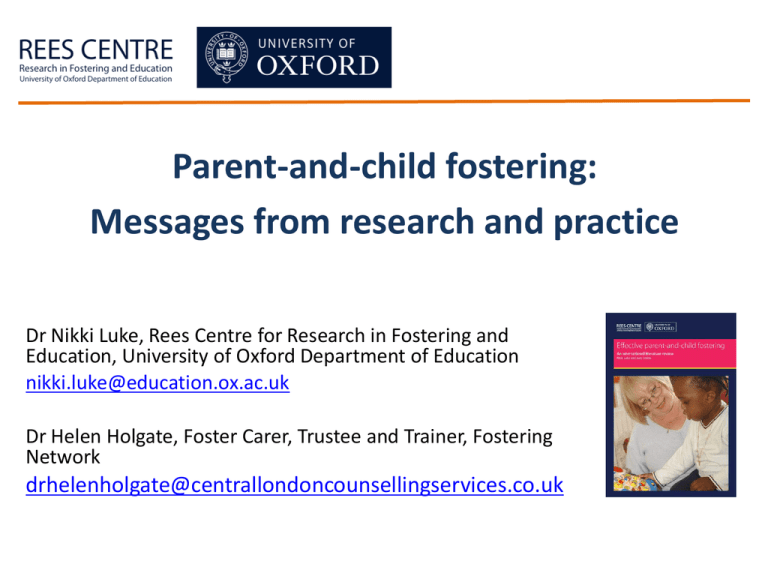
Parent-and-child fostering: Messages from research and practice Dr Nikki Luke, Rees Centre for Research in Fostering and Education, University of Oxford Department of Education nikki.luke@education.ox.ac.uk Dr Helen Holgate, Foster Carer, Trustee and Trainer, Fostering Network drhelenholgate@centrallondoncounsellingservices.co.uk In this session • An introduction to the Rees Centre • What do we know about parent-and-child fostering? • What does research tell us about ‘good’ parent-and-child fostering? • How does this fit with practice experience? • What improvements can be made in this area? Rees Centre for Research in Fostering and Education The Rees Centre aims to: • identify what works to improve the outcomes and life chances of children and young people in foster care We are doing this by: • reviewing existing research in order to make better use of current evidence • conducting new research to address gaps • working with service users to identify research priorities and translate research messages into practice • employing foster carers and care experienced young people as co-researchers Centre has core funding from the Core Assets Group Reviews • • • • Why do people become foster carers? Peer contact between foster carers How are foster carers selected? The impact of fostering on foster carers’ children • Effective parent-and-child fostering • The role of the supervising social worker For NSPCC: • What works in preventing and treating poor mental health in looked after children? http://reescentre.education.ox.ac.uk/research/pu blications/ How you can be involved • Read and feed back on our reports • Express interest in being involved in future possible research projects • Come along to lectures & seminars – webinar on ‘supervisory social work’ 7th October 16.30 – email for details – knowledge exchange seminar 26th January 17.00 in Oxford • Join our mailing list and receive newsletters 5 times/year: rees.centre@education.ox.ac.uk • Web: http://reescentre.education.ox.ac.uk/ • Comment on our blog – or write for us • Follow us on Twitter – @ReesCentre Parent-and-child fostering • Who is in this type of arrangement? • What is the purpose of them? • How does parent-and-child fostering relate to your practice? Research on parent-and-child fostering “What kind of provision is effective for parents and their children living together in foster homes?” •Providers need to know what is effective for producing outcomes in best interest of the child •Searched research databases and research and charity websites, and emailed international experts •Found 35 relevant studies and reports from UK and North America •Most research focused on teenage parents in care, rather than adults moving into foster homes •Very little research on fathers (see Tyrer et al., 2005) Research on parent-and-child fostering • Parenting can be a transformative experience for traumatised young people: – fulfilling emotional needs (family belonging, e.g. Pryce & Samuels, 2010) – providing motivation to make positive life changes (e.g. Barn & Mantovani, 2007) – wishing to be better parents than their own parents had been (e.g. Love et al., 2005) – developing an awareness of their own resilience (Maxwell et al., 2011) Research on parent-and-child fostering • Some needs in common with other types of placement: – – – – – good relationship with carers and social workers clear house rules stability a say in decisions about their future help with problems such as substance abuse • Some distinct needs: – – – – help in accessing community support services clearly outlined roles for parent(s) and carers an understanding of the assessment process for young parents, the freedom to be teenagers Research on parent-and-child fostering • Feelings of stigmatisation – teenagers felt judged as automatically ‘worse’ parents – parents felt under scrutiny from carers and social workers – tied to fears of having child(ren) taken away – how can we avoid these when assessment is built-in to some arrangements? • Differences in perceived support from practitioners – social workers often seen as absent or unsupportive – leaving care teams viewed more positively • Poor support after leaving care – inadequate housing raised as a particular issue – need better links to community support services Research on parent-and-child fostering • Separation after arrangement varied: – 15% (Barth & Price, 1999) – 84% (Martin & Davies, 2007) • Variations in ‘success rates’ likely due to: – small numbers of parents in studies – differences in placements and parents – purpose and content of the scheme • Little research specifically linking factors of the placement to post-placement outcomes – mostly relies on retrospective interviews (e.g. Chase et al., 2009) – longer stays linked to greater success for substanceabusing mothers (Barth, 1994) • Limited by current data – SSDA903 collects data only on motherhood for completed births (not pregnancies or fatherhood) Listen to care-experienced young people • Get to know your Looked After Children and Care Leavers: We are not all the same; we have different needs, know your cohort to best serve them. • Minimise Disruption: How can a young person concentrate when there is disruption? Help resolve the disruption and other things will fall into place. • Challenge the stereotypes: We can achieve. Our actions as young people and our situations should not dictate the attitudes about our ‘achievements’ by the adults around us. How does this relate to practice? Key areas of interest •Practical issue – practitioners need to recognise the differing types of PAC and adaptations should be made accordingly to each placement plan. •The significance and value of the relationship between the carer and the parent. •The skill base required for PAC is different and at times contrasting to those typically thought of as being necessary for mainstream fostering How does this relate to practice? How do these messages relate to your practice? What improvements can be made? Need to reduce likelihood of re-traumatising an already traumatised group, for example by: • Recruiting, training and supporting more specialist parent-and-child carers • Creating support networks for parents and carers • Carrying out assessments sensitively to reduce stigma • Extending support for teenage parents beyond leaving care age • Being much tighter around our planning, expectations and fulfilment of PAC placements • Collect more data on parents, including fathers • Aiming for an agreed national standard of care for PAC fostering What could you add to this list? What improvements can be made? • What challenges might arise for implementing the ‘ideal’ system? • How can other services (such as schools) contribute to successful outcomes for parents living in foster homes? • How can research and practice work together to ensure that: – the right research questions are being asked? – practitioners can get to know what makes for effective practice? References • • • • • • • • • Barn, R.,& Mantovani, N. (2007). Young mothers and the care system: Contextualizing risk and vulnerability. British Journal of Social Work, 37(2), 225-243. Barth, R. P. (1994). Shared family care: Child protection and family preservation. Social Work, 39(5), 515-524. Barth, R. P., & Price, A. (1999). Shared family care: Providing services to parents and children placed together in out-of-home care. Child Welfare, 78(1), 88-107. Chase, E., Warwick, I., Knight, A., & Aggleton, P. (2009). Supporting young parents: Pregnancy and parenthood among young people from care. London: Jessica Kingsley. Love, L. T., McIntosh, J., Rosst, M., & Tertzakian, K. (2005). Fostering hope: Preventing teen pregnancy among youth in foster care. Washington, DC: National Campaign to Prevent Teen Pregnancy. Retrieved from http://www.thenationalcampaign.org/resources/pdf/pubs/FosteringHope_FINAL.pdf Martin, M., & Davies, S. (2007). An evaluation of parent and baby placements in West Sussex. West Sussex: Social Research Unit, West Sussex County Council. Retrieved from http://www.bmgsystems.co.uk/westsussex/UploadedFiles/Evaluating%20parent%20and%20baby% 20placements%20report.pdf Maxwell, A., Proctor, J., & Hammond, L. (2011). ‘Me and my child’: Parenting experiences of young mothers leaving care. Adoption & Fostering, 35(4), 29-40. Pryce, J. M., & Samuels, G. M. (2010). Renewal and risk: The dual experience of young motherhood and aging out of the child welfare system. Journal of Adolescent Research, 25(2), 205-230. Tyrer, P., Chase, E., Warwick, I., & Aggleton, P. (2005). ‘Dealing with it’: Experiences of young fathers in and leaving care. British Journal of Social Work, 35(7), 1107-1121.

